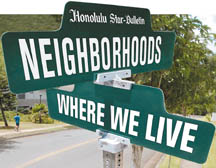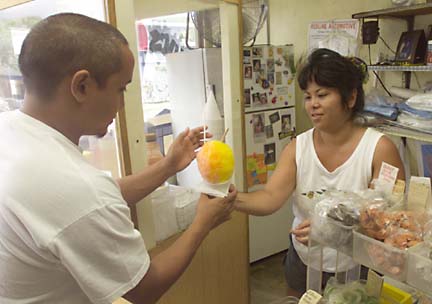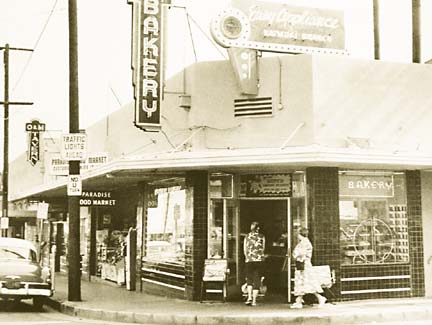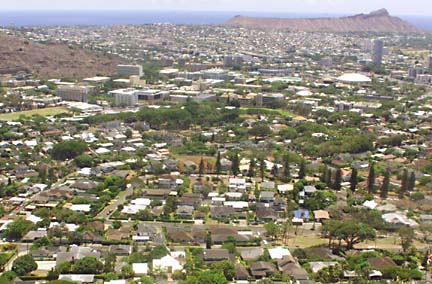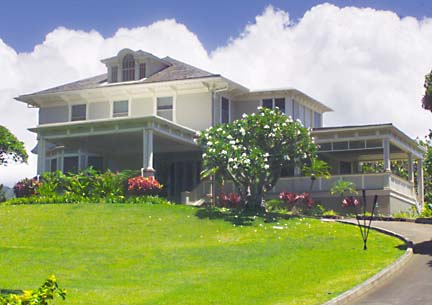
Kaimuki's recent makeover seems to be a nod to the past when neighborhoods grew through the urges and needs of residents rather than by contrived design of urban planners. Like Puunui and Manoa, Kaimuki retains the original flavors of Oahu's older districts, where architecture and landscaping actually vary from one lot to the next.
Kaimuki and Puunui still assert their blue-collar roots even as new residents transform the charm that drew them in the first place. Manoa now boasts an upper-class air-- empowered by the presence of academic institutions on its fringes. Its residents enjoy a sense of subdued exclusivity.
In each of these enduring places, the memories of those who grew up in them drift to days when the manapua men, bowed by the weight of bins hung from staffs across their shoulders, and the "yasai" peddlers in trucks stuffed with vegetables, fish and selected canned goods, called out their presence.
Puunui | Kaimuki | Manoa
BACK TO TOP |
FL MORRIS / FMORRIS@STARBULLETIN.COM
At John's Groceries on Liliha Street in Puunui, Cheryl Suzuki hands a shave ice to customer Rommel Manansala.
A special area with
a little bit of everything
Puunui is one of the oldest residential neighborhoods in Honolulu, with deep-eaved clapboard, one-of-a-kind homes of a century ago still to be found on its shady streets.
But the area above Liliha-Kapalama, below Nuuanu Valley, on the way to Alewa Heights is so off the beaten track that it is not always designated on maps or real estate ads.
Only four-block-long Puunui Avenue and Puunui Community Park carry the name.
"The old neighborhood is passing away," said Gary Wright, whose family still lives on the Hawaii Street property where his grandfather William Thoene built a house. As his mother, the late Thelma Wright, and her siblings grew up, the block was divided into four house lots.
"When we were kids, the whole block was family. All our cousins were here; we played with our cousins," said Wright.
He recalls playing football on the street where the field of play was defined by three telephone poles -- "the middle one would be the 50-yard line."
His mother taught at Maemae School on Wyllie Avenue, one of Oahu's oldest public schools, which celebrated its 100th anniversary in 1997. The school and the Waterhouse home across the street, which now houses the Girl Scout Council of Hawaii, are the landmarks of the area. Another is the topography itself, the upward slope that provides sea views and gave "puu nui" -- big hill -- its name.
Puunui's commercial hub is the same today as it was in Wright's childhood. John's Groceries at 2426 Liliha St. is the after-school snack destination for children from Maemae School, Hawaii Baptist Academy and Academy of the Pacific, as well as the shopping stop for bread, milk and fresh produce of the older generations in the neighborhood.
There are two dozen shave-ice flavors posted behind the machine operated by owner Edith Tomei's children.
"We have a little bit of everything," said Tomei, who has tacked hundreds of snapshots of the customers and their children and grandchildren around the store during her 21 years.
John Ing opened the tiny shop in 1926. "John used to figure out your bill on an old paper bag," Wright recalled. "It was the first place you'd head if you had money as a kid."
"We didn't have to travel to find food; the bread wagon and the grocery truck came by," he said, remembering the "Manapua pepe wai" call of the Chinese food vendor and the "ding ding" of the ice cream wagon.
A stream runs through it. "We called it the river," Wright said. "The stream was so clear, you could drink the water. We would catch crayfish. You could get to the water then, but now people kick you out and say it's private property."
BACK TO TOP |
STAR-BULLETIN FILE PHOTOS
The Kaimuki Bakery, shown here in 1956, occupied the corner of 12th and Waialae avenues for many years.
105-year-old
neighborhood wonÕt
let time pass it byThe eclectic area is repopulated by
kids and grandkids of long-ago residents
Now in its 105th year, Kaimuki continues to generate a unique vibe with its eclectic mix of longtime residents and younger additions to the neighborhood.
Some can remember a time when Waialae Avenue -- before the H-1 freeway barreled through in the early 1960s and made it possible to bypass the area -- was a bustling retail hub comprising small businesses that moved in decades earlier.
Merchants forced out of downtown Honolulu by the Chinatown fire of 1900 found a second home in Kaimuki. Before that, Kaimuki was no more than 500 acres of red dirt and kiawe trees, sold to one of Honolulu's first real estate firms by Daniel Paul Isenberg in 1898.
Many longtime businesses in Kaimuki have disappeared as elderly family members die and the next generation decides not to remain involved in day-to-day operations. In just the last five years or so, mainstays such as Bea's Pies and Deli, Kaimuki Saimin and the 9th Avenue Bakery have disappeared.
Remember Kress, Ben Franklin, Thrifty Drugs, the old Kaimuki Shopping Center and the Kaimuki Bakery? Like the Queen Theater and the long-forgotten Kaimuki Super Market (the first modern supermarket, built in 1938 -- you can still see a tribute to the building and its owner in the sidewalk near the intersection of Waialae and Koko Head avenues), all are just memories of what Kaimuki used to be.
STAR-BULLETIN FILE PHOTOS
A woman steers her children past some posters for X-rated movies showing at the Kaimuki Theatre.
"It's a great neighborhood, an old neighborhood in transition," says Kaimuki Neighborhood Board chairman Mike Abe, who moved back into the area about 12 years ago after living on Kauai.
"It's being repopulated by kids (and) grandchildren coming back."
Dave Chinaka, president of the Kaimuki Business and Professional Association, is another example of someone returning to his roots after residing elsewhere. "We used to be living out in Hawaii Kai," he explains, but "thought it would be better to have our kids go to elementary and middle school" in Kaimuki.
"It's a good neighborhood to work and live in," he said, adding that both he and his wife work relatively close to their home on 18th Avenue.
With an influx of restaurants and other new businesses, along with the introduction of trolley service connecting the business district with Kapahulu and Waikiki, Kaimuki looks toward continuing its revitalization and attracting more new residents. As Greater East Honolulu Community Alliance's executive director, Ginny Meade, puts it, "the vigor is increasing" among merchants, who recognize the potential for their businesses.
"People are up for new ideas; they're coming together ... starting to be interested" in attracting new customers to the neighborhood, Meade said.
BACK TO TOP |
RICHARD WALKER / RWALKER@STARBULLETIN.COM
Manoa Valley was once a rich agricultural area, but now is a place where some of the nicer historic homes on the island can be found.
History and beauty
abound in this valleyManoa residents love the "sense
of place" that their valley offers
When Frank Atherton bought the property he called College Hill in 1902, it raised more than a few eyebrows around town.
Before the 20th century, Manoa Valley, though directly mauka of Waikiki, was largely an agricultural area.
But it became a popular residential neighborhood shortly after the turn of the century with the arrival of the trolley and the sale of about 150 house lots in the area known as College Hills Tract.
Atherton's house stayed in his family until 1964, when it was given to the University of Hawaii.
Today many of the historic homes -- including College Hill, the official residence of University of Hawaii President Evan Dobelle -- still stand.
When lots in the College Hills tract first became available, they sold for $1,000 to $1,700 per 15,000- to 20,000-square-foot lot.
In the last 12 months, single-family home prices around Manoa have averaged $607,020, according to real estate analyst Ricky Cassiday.
Apart from its historic homes, Manoa is often associated with the history of education in Hawaii. It contains the University of Hawaii's flagship campus, founded in 1907, as well as Punahou School, founded in 1841, and Mid-Pacific Institute, founded in 1864.
RICHARD WALKER / RWALKER@STARBULLETIN.COM
College Hill is where the president of the University of Hawaii lives, and is one of the oldest homes in the Manoa area.
Manoa also is known for its gardens, both public and private.
The lush valley is home to Lyon Arboretum, established by the Hawaii Sugar Planters Association, which brought trees from all over the Pacific to test their adaptability.
First called Manoa Arboretum, the name was changed to the Harold L. Lyon Arboretum when it became affiliated with the university.
Residents of the valley, including families who have lived there for generations, will tell you their desire to live in Manoa is as much about its "sense of place" as the area's rich history. And they band together to protect their valley.
"There are only two streets that lead into the valley, so you really know you're here. You get a strong sense of place," said Mary Cooke, longtime Manoa resident and former president of the community group Malama o Manoa, which she co-founded with Helen Nakano in 1992.
Cooke said residents formed the group to preserve, protect and enhance the special qualities of the valley.
One of the group's first projects was the publication of a book about their home called "Manoa -- The Story of a Valley." The project was spearheaded by longtime Manoa resident and ethnobotanist Beatrice Krauss, who died in 1998.
More than 10 years since its founding, the group continues to be active. Its latest project has been an effort to establish the College Hill Thematic Historic District to protect some of the area's historic homes. Long-term projects include the cleanup of Manoa Stream.
But as much as it is the physical environment that makes Manoa special, it's the people too, according to Cooke.
"We have caring neighbors and a wonderful mix of cultures," she said.
